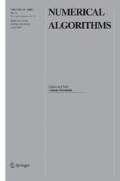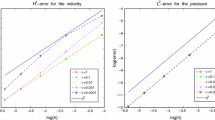Abstract
Based on finite element discretization and a recent variational multiscale-stabilized method, we propose a three-step defect-correction algorithm for solving the stationary incompressible Navier-Stokes equations with large Reynolds numbers, where nonlinear slip boundary conditions of friction type are considered. This proposed algorithm consists of solving one nonlinear Navier-Stokes type variational inequality problem on a coarse grid in a defect step, and solving two stabilized and linearized Navier-Stokes type variational inequality problems which have the same stiffness matrices with only different right-hand sides on a fine grid in correction steps. In the defect step, an artificial viscosity term is used as a stabilizing factor, making the nonlinear system easier to solve. Error bounds of the approximate solutions in L2 norms for the velocity gradient and pressure are estimated. Scalings of the algorithmic parameters are derived. Some numerical results are given to support the theoretical predictions and test the validity of the present algorithm.



Similar content being viewed by others
References
Fujita, H.: Flow Problems with Unilateral Boundary Conditions. Lecons, Collège de France (1993)
Fujita, H., Kawarada, H.: Variational inequalities for the Stokes equation with boundary conditions of friction type. Recent Dev. Domain Decompos. Methods Flow Probl. 11, 15–33 (1998)
Fujita, H.: A mathematical analysis of motions of viscous incompressible fluid under leak or slip boundary conditions. RIMS Kokyuroku 888, 199–216 (1994)
Fujita, H.: Non-stationary Stokes flows under leak boundary conditions of friction type. J. Comput. Math. 19, 1–8 (2001)
Fujita, H.: A coherent analysis of Stokes flows under boundary conditions of friction type. J. Comput. Appl. Math. 149, 57–69 (2002)
Li, Y., Li, K. T.: Existence of the solution to stationary Navier-Stokes equations with nonlinear slip boundary conditions. J. Math. Anal. Appl. 381, 1–9 (2011)
Li, Y., Li, K. T.: Global strong solutions of two-dimensional Navier-Stokes equations with nonlinear slip boundary conditions. J. Math. Anal. Appl. 393, 1–13 (2012)
Kashiwabara, T.: On a strong solution of the non-stationary Navier-Stokes equations under slip or leak boundary conditions of friction type. J. Differ. Equ. 254, 756–778 (2013)
Kashiwabara, T.: Finite element method for Stokes equations under leak boundary condition of friction type. SIAM J. Numer. Anal. 51, 2448–2469 (2013)
Li, Y., An, R.: Semi-discrete stabilized finite element methods for Navier-Stokes equations with nonlinear slip boundary conditions based on regularization procedure. Numer. Math. 117, 1–36 (2011)
Li, Y., An, R.: Penalty finite element method for Navier-Stokes equations with nonlinear slip boundary conditions. Int. J. Numer. Methods Fluids 69, 550–566 (2012)
An, R.: Comparisons of Stokes/Oseen/Newton iteration methods for Navier-Stokes equations with friction boundary conditions. Appl. Math. Model. 38, 5535–5544 (2014)
Li, Y., An, R.: Two-level variational multiscale finite element methods for Navier-Stokes type variational inequality problem. J. Comput. Appl. Math. 290, 656–669 (2015)
Qiu, H. L., Mei, L. Q., Zhang, Y. C.: Two-grid variational multiscale algorithms for the stationary incompressible Navier-Stokes equations with friction boundary conditions. Numer. Methods Partial Differ. Equ. 33, 546–569 (2017)
Jing, F. F., Li, J., Chen, Z. X., Zhang, Z. H.: Numerical analysis of a characteristic stabilized finite element method for the time-dependent Navier-Stokes equations with nonlinear slip boundary conditions. J. Comput. Appl. Math. 320, 43–60 (2017)
Zhou, K.R., Shang, Y.Q.: Parallel iterative stabilized finite element algorithms for the Navier-Stokes equations with nonlinear slip boundary conditions. Int. J. Numer. Methods Fluids 93, 1074–1109 (2021)
John, V.: Slip with friction and penetration with resistance boundary conditions for the Navier-Stokes equations–numerical tests and aspects of the implementation. J. Comput. Appl. Math. 147, 287–300 (2002)
Axelsson, O., Layton, W.: Defect correction methods for convection dominated, convection diffusion equations. RAIRO J. Numer. Anal. 24, 423–455 (1990)
Ervin, V. J., Layton, W., Maubach, J. M.: Adaptive defect-correction methods for viscous incompressible flow problems. SIAM J. Numer. Anal. 37, 1165–1185 (2000)
Layton, W., Lee, H., Peterson, J.: A defect-correction method for the incompressible Navier-Stokes equations. Appl. Math. Comput. 129, 1–19 (2002)
Wang, K.: A new defect correction method for the Navier-Stokes equations at high Reynolds numbers. Appl. Math. Comput. 216, 3252–3264 (2010)
Si, Z. Y.: Second order modified method of characteristics mixed defect-correction finite element method for time dependent Navier-Stokes problems. Numer. Algor. 59, 271–300 (2012)
Shang, Y. Q.: Parallel defect-correction algorithms based on finite element discretization for the Navier-Stokes equations. Comput. Fluids 79, 200–212 (2013)
Huang, P.Z., Feng, X.L., He, Y.N.: Two-level defect-correction Oseen iterative stabilized finite element methods for the stationary Navier-Stokes equations. Appl. Math. Model. 37, 728–741 (2013)
Qiu, H.L., Mei, L.Q., Liu, H., Cartwright, S.: A defect-correction stabilized finite element method for Navier-Stokes equations with friction boundary conditions. Appl. Numer. Math. 90, 9–21 (2015)
Qiu, H. L., Mei, L. Q.: Two-level defect-correction stabilized finite element method for Navier-Stokes equations with friction boundary conditions. J. Comput. Appl. Math. 280, 80–93 (2015)
Liu, A., Li, Y., An, R.: Two-level defect-correction method for steady Navier-Stokes problem with friction boundary conditions. Adv. Appl. Math. Mech. 8, 932–952 (2016)
Xu, J. C.: A novel two-grid method for semilinaer elliptic equations. SIAM J. Sci. Comput. 15, 231–237 (1994)
Xu, J. C.: Two-grid discretization techniques for linear and nonlinear PDEs. SIAM J. Numer. Anal. 33, 1759–1777 (1996)
Layton, W.: A two level discretization method for the Navier-Stokes equations. Comput. Math. Appl. 5, 33–38 (1993)
Layton, W., Lee, H. K., Peterson, J.: Numerical solution of the stationary Navier-Stokes equations using a multilevel finite element method. SIAM J. Sci. Comput. 20, 1–12 (1998)
Layton, W., Lenferink, H. W. J.: A multilevel mesh independence principle for the Navier-Stokes equations. SIAM J. Numer. Anal. 33, 17–30 (1996)
Girault, V., Lions, J. L.: Two-grid finite element scheme for the transient Navier-Stokes problem. Math. Model. Numer. Anal. 35, 945–980 (2001)
Franca, L. P., Nesliturk, A.: On a two-level finite elemnt method for the incompressible Navier-Stokes equations. Int. J. Numer. Methods Engrg. 52, 433–453 (2001)
He, Y. N.: Two-level method based on finite element and Crank-Nicolson extrapolation for the time-dependent Navier-Stokes equations. SIAM J. Numer. Anal. 41, 1263–1285 (2003)
He, Y.N., Wang, A.W.: A simplified two-level method for the steady Navier-Stokes equations. Comput. Methods Appl. Mech. Engrg. 197, 1568–1576 (2008)
Li, Y., Mei, L.Q., Li, Y.Q., Zhao, K.: A two-level variational multiscale method for incompressible flows based on two local Gauss integrations. Numer. Methods Partial Differ. Equ. 29, 1986–2003 (2013)
Shang, Y. Q., Qin, J.: A finite element variational multiscale method based on two-grid discretization for the steady incompressible Navier-Stokes equations. Comput. Methods Appl. Mech. Engrg. 300, 182–198 (2016)
Zheng, B., Shang, Y. Q.: A two-level stabilized quadratic equal-order finite element variational multiscale method for incompressible flows. Appl. Math. Comput. 384, 125373 (2020)
Layton, W., Lenferink, H.W.J.: A two-level method with backtraking for the Navier-Stokes equations. SIAM J. Numer. Anal. 35, 2035–2054 (1998)
Du, G. Z., Li, Q. T., Zhang, Y. H.: A two-grid method with backtracking for the mixed Navier-Stokes/Darcy model. Numer. Methods Partial Differ. Equ. 36, 1601–1610 (2020)
Yang, X.C., Shang, Y.Q., Zheng, B.: A simplified two-level subgrid stabilized method with backtracking technique for incompressible flows at high Reynolds numbers. Numer. Methods Partial Differ. Equ. 37, 2067–2088 (2021)
Dai, X. X., Cheng, X. L.: A two-grid method based on Newton iteration for the Navier-Stokes equations. J. Comput. Appl. Math. 220, 566–573 (2008)
Huang, P. Z., Feng, X. L.: Two-level stabilized method based on Newton iteration for the steady Smagorinsky model. Nonlinear Anal. Real World Appl. 14, 1795–1805 (2013)
Saumya, B., Amiya, K. P.: On three steps two-grid finite element methods for the 2D-transient Navier-Stokes equations. J. Numer. Math. 25, 199–228 (2017)
Wang, L., Li, J., Huang, P. Z.: An efficient two-level algorithm for the 2D/3D stationary incompressible magnetohydrodynamics based on the finite element method. Int. Commun. Heat Mass Trans. 98, 183–190 (2018)
Shang, Y. Q.: A new two-level defect-correction method for the steady Navier-Stokes equations. J. Comput. Appl. Math. 381, 113009 (2020)
Zheng, H. B., Hou, Y. R., Shi, F., Song, L. N.: A finite element variational multiscale method for incompressible flows based on two local Gauss integrations. J. Comput. Phys. 228, 5961–5977 (2009)
Adams, R.: Sobolev Spaces. Academaic Press Inc, New York (1975)
Li, Y., Li, K. T.: Uzawa iteration method for Stokes type variational inequality of the second kind. Acta Math. Appl. Sin. Engl. Ser. 27, 302–315 (2011)
Girault, V., Raviart, P. A.: Finite Element Method for Navier-Stokes Equations: Theory and Algorithms. Springer, Berlin (1986)
Hood, P., Taylor, C.: A numerical solution of the Navier-Stokes equations using the finite element technique. Comput. Fluids 1, 73–100 (1973)
Hecht, F.: New development in FreeFem++. J. Numer. Math. 20, 251–265 (2012)
Ghia, U., Ghia, K. N., Shin, C. T.: High-Re solutions for incompressible flow using the Navier-Stokes equations and a multigrid method. J. Comput. Phys. 48, 387–441 (1982)
Acknowledgements
The authors would like to express their deep gratitude to the anonymous referees for their valuable comments and suggestions, which led to a large improvement of the manuscript.
Funding
This work was supported by the Natural Science Foundation of China (No. 11361016), the Natural Science Foundation of Chongqing Municipality, China (No. cstc2021jcyj-msxmX1044), and Graduate Scientific Research Innovation Project of Chongqing Municipality, China (No. CYB21095).
Author information
Authors and Affiliations
Corresponding author
Ethics declarations
Conflict of interest
The authors declare no competing interests.
Additional information
Data availability
Data sharing not applicable to this article as no datasets were generated or analyzed during the current study.
Publisher’s note
Springer Nature remains neutral with regard to jurisdictional claims in published maps and institutional affiliations.
Rights and permissions
About this article
Cite this article
Zheng, B., Shang, Y. A three-step defect-correction algorithm for incompressible flows with friction boundary conditions. Numer Algor 91, 1483–1510 (2022). https://doi.org/10.1007/s11075-022-01311-0
Received:
Accepted:
Published:
Issue Date:
DOI: https://doi.org/10.1007/s11075-022-01311-0
Keywords
- Incompressible Navier-Stokes equations
- Nonlinear slip boundary conditions
- Finite element
- Three-step method
- Defect-correction method
- Variational multiscale method




